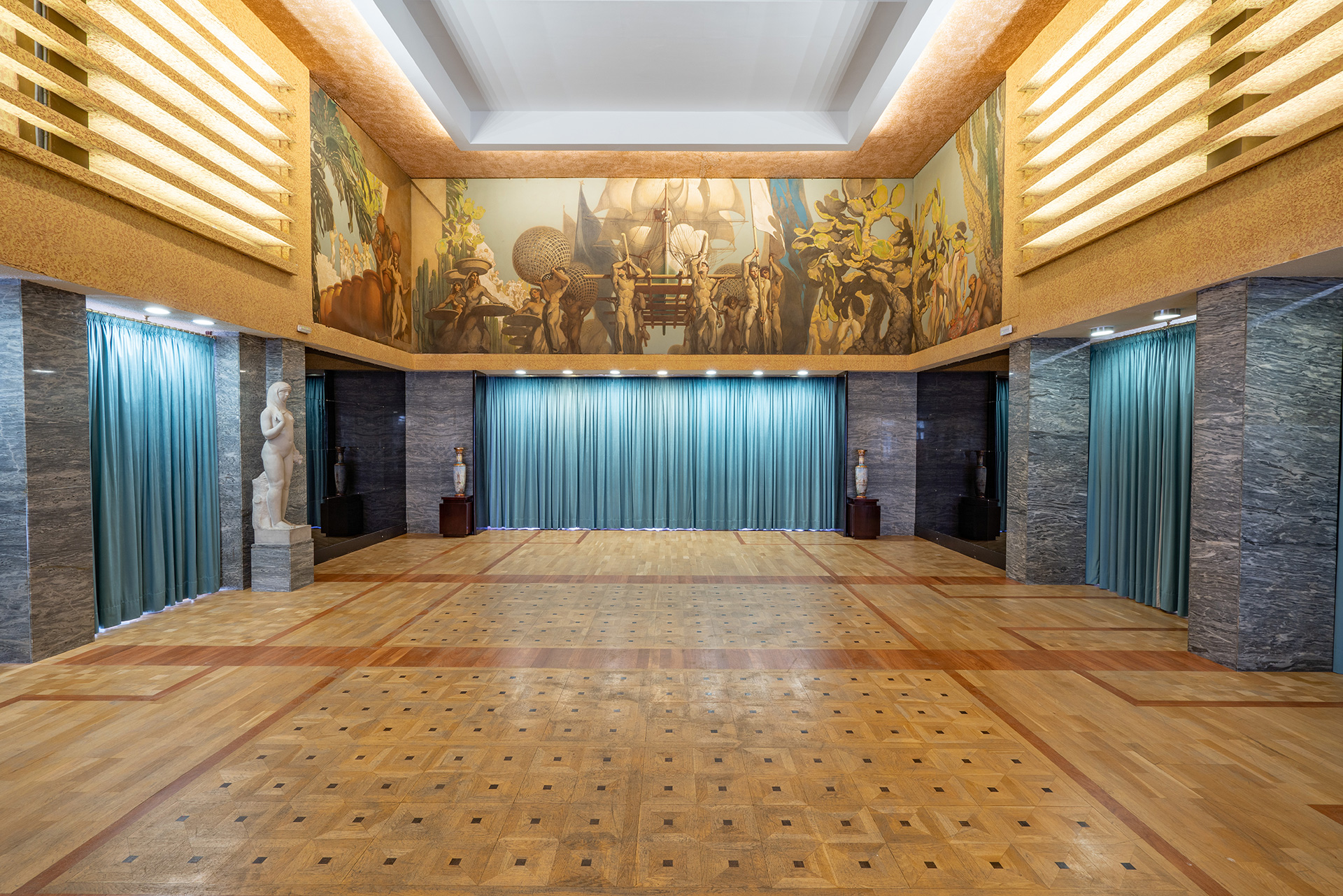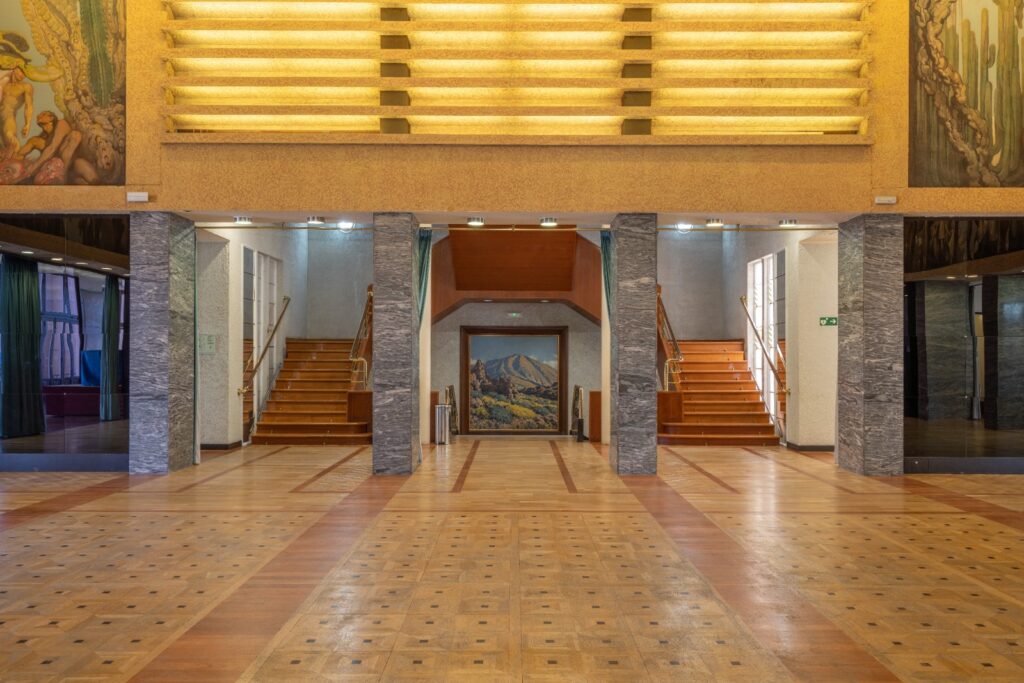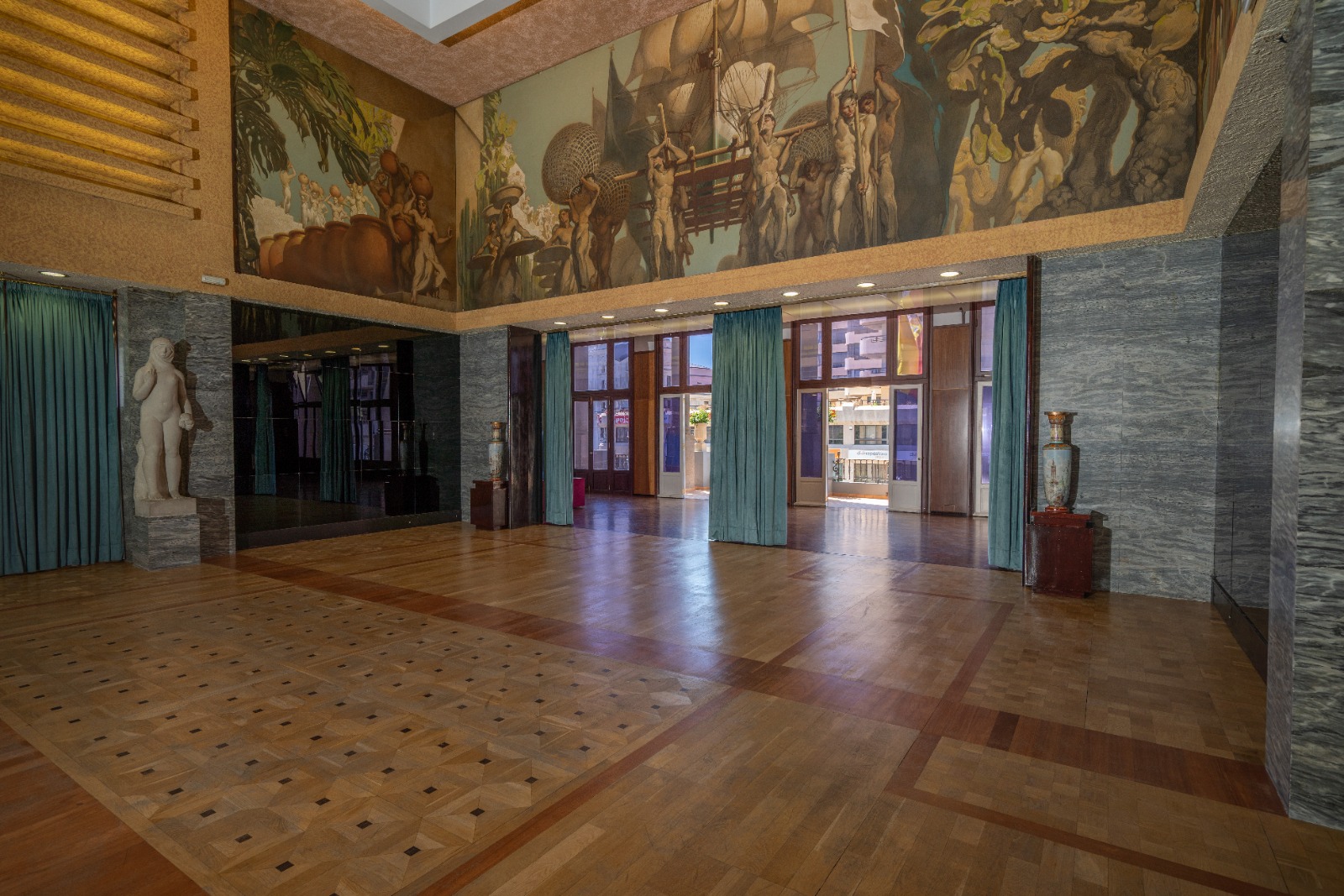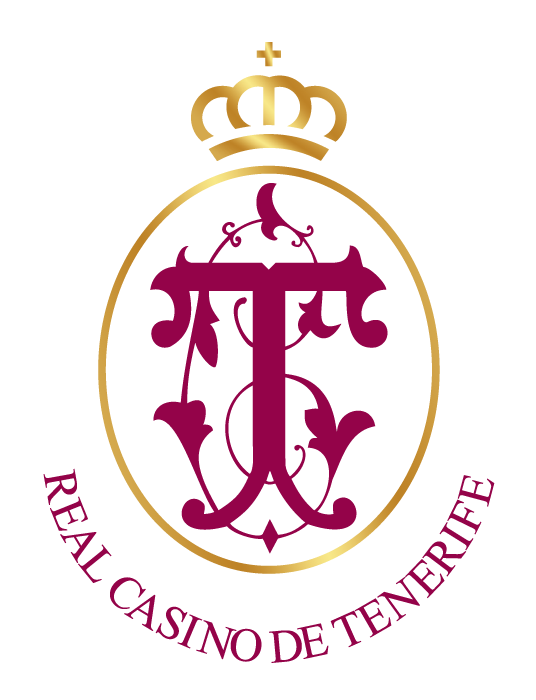Salons
Main Hall
Located on the second floor, presided over by the canvases La Tierra y El Mar, by the Gran Canarian painter Néstor de la Torre, declared Sites of Cultural Interest (BIC). These canvases are the pictorial jewel of our institution. It is an emblematic space that, due to its architectural characteristics and its capacity, with a seating capacity of 1000 people, allows the celebration of parties, congresses and institutional events. Its large terrace, with unbeatable sea views, is an additional attraction.
Emblematic hall of our society
The headquarters of the Real Casino de Tenerife is a unique building for several reasons, among them, for housing a prestigious socio-cultural institution that dates back to 1840 and therefore celebrates 180 years of existence, also by its location, occupying the best block in the main square of the city and by the construction itself, with an exterior appearance in an eclectic style of classicist order and by a more modern character in its most significant interior spaces, in a more modern and style that has been called rationalist or functionalist, a style that was against superfluous decorations and defended, as a motto, that form follows function.
The current building originates in a process of design and construction that took place between 1929 and 1935, was carried out by the Gran Canarian architect Miguel Martin Fernandez de la Torre (1894-1980), a leading figure and capital in the development of Canarian architecture and author also of the construction of the Real Club Nautico de Tenerife.

The current Casino building was built in phases, with some parts coming into use while others were being built and with a project that was modified, since the initial project of 1929 was replaced by another in 1931.
The building occupies a complete block and is organized with four courtyards on the perimeter of the central space, where the hall and the party room are located, both areas of double height and which are the most representative rooms of the complex.
On the outside of the building, the corners are emphasized, responding in general to a pseudo-secessionist style with strong classicist manifestation in balconies with Doric colonnades on the two main facades.
The organization of the building, both in its functionality and in its external manifestation with towers, colonnades and resources of all kinds, is outstanding. formalization and interior decoration, in the rationalist aesthetics, of the most significant spaces and that responds to a set of plans drawn up by the German architect Richard E. Oppel (1887-1960), an architect who joined Miguel Martin’s studio in July 1932, and later became his brother-in-law. This set of plans, dated May 1933, and what was executed according to them, were logically commissioned and arranged by Miguel Martin, although as can be seen in the relation of what was drawn and what was executed, Oppel was free to develop his strong design personality.
In 1933, the definitive project had already been formalized since 1931, and most of the building’s main construction work had already been completed. Oppel’s work consisted of designing the interiors of the main areas and the entrance to the building.
These drawings, characteristically Oppelian, are valuable in their own right, and they develop the different elements, from the cover, which already introduces a differentiating language in the facade, to the interior through the great hall, as a hall-distributor, where the magnificent main staircase starts, which will lead, and ventilated from the light wells, to be reached, once the mezzanine, the level of the large party room, this space, which was illuminated and ventilated both laterally and zenithally. Today these conditions have been modified due to the construction of a new floor on the roof.
The large hall is a strategic space, used as a meeting room, communications distributor, stairs and elevators, with a fountain and an attractive mural by the Gomeran painter José Aguiar (1895-1976).
The staircase leads to the mezzanine as a space that surrounds the double height of the hall, volumetrically enriching the whole, but before that, on a landing of the staircase, there is a fascinating access to an assembly hall.
This access is a plastic delicacy with its subtle walls of semi-curved light fixtures, which corset the small area of passage to the lounges, and which was executed as shown in the plans.

On the next level is the party room, as we have said, a central double-height space, with an exact composition and proportions, where the measurements, the relationship of openings and massifs, the materials, the paintings and the finishes make up one of the most successful spaces of our architectural heritage. It is a spatially resounding scenario, and specially designed to host the celebrated oil on canvas mural paintings by Néstor Martin Fernández de la Torre (1887-1938), a brilliant figure in the Canarian plastic arts and brother of the architect Miguel.
The architecture critic and renowned architect Oriol Bohigas (1), comments that the interior spaces of the Casino represent one of the best and most significant interior ensembles of the thirties at national level, addicted to the Central European style. For her part, Dr. Navarro Segura (2), highlights the conception of the staircase and surrounding spaces within the neoplastic aesthetics and the influence of Japanese architecture.
The concept of lighting applied in the Casino is essential in the formulation of interior spaces. The light, both natural and artificial, is filtered through a material of the time, the opal, a white translucent glass that lets light through without being transparent, so that it is not distinguishable what is natural light or artificial light, thus unifying the lighting, in a vision with some influence of the traditional architecture of Japan (as the shojis and fusumas Japanese), influence that is very present in Western architecture in the twenties and thirties of the last century. This opal glass is evident in all the lighting elements, such as the abundant zenithal and ceiling lights, in all kinds of spaces, as well as wall lights, door leaves and openings, patio windows, etc.

In addition to the manifestation of light in the composition of the different spaces, the materials used stand out: marble of different colors, white, black, maroon, metals, stainless steel, gold, mahogany woodwork, smooth and rough surface finishes, all of which are carefully and excellently designed. Particularly interesting are the compositions of marble floors in different colors in the hall and mezzanine, forming and hierarchizing the spaces, in a brilliant carpet treatment drawing enigmatic geometric figures.
The building was inaugurated in May 1935, under the crucial presidency of Faustino Martin Albertos (1896-1951). Subsequently, the building has undergone several extensions, as mentioned above, and various alterations. In the last directives, we have tried to maintain the values of the building, promoting the necessary actions in line with its valuation as a rationalist building (refurbishment of the cafeteria, exhibition hall, basement, new stairs, etc.).
Therefore, to the question of the title of this article, we would answer that the building of the Real Casino is dressed in a classic costume but houses inside, in our opinion, the best rationalist spaces of the Spanish state, spaces of a surprising modernity that deserve to be cared for as if it were a jewel.
Features
SURFACE
763'82 m2
CAPACITY
350 people
Usage
Weddings, banquets, cocktail parties, presentations, congresses and conventions
MULTIMEDIA
Overhead projector, sound equipment, projector and screen
Would you like to reserve this space?
Access the private area and fill in the application form.

